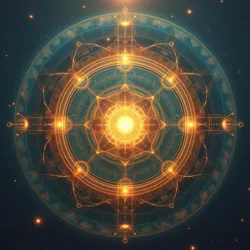Khelsian Tradition

Depicts the multifaceted and venerable body of philosophical, esoteric, and intellectual pursuits originating from the ancient Khelsian civilization.
Ancient Khelsian civilization
Philosophy, esotericism, intellect
Subjective knowing, Informal Transmission
Obsidian Dynasty
Temple of Whispers in Eldoria
The Khelsian Tradition is a multifaceted and venerable body of philosophical, esoteric, and intellectual pursuits originating from the ancient Khelsian civilization. Encompassing a wide array of disciplines from the study of consciousness and subtle communication to the decipherment of lost languages and the exploration of hidden dimensions of reality, the Khelsian Tradition represents a unique approach to understanding existence, knowledge, and the interconnectedness of all things. It is characterized by a deep respect for veiled wisdom, a rigorous methodology in both introspective and extrinsic investigation, and a persistent quest to unravel the enigmas that lie beyond the grasp of conventional understanding. Often associated with concepts such as Informal Transmission, Informal Flux, and Gematric Resonance, the Khelsian Tradition offers a distinctive lens through which to perceive the world and humanity's place within it.
Overview of Khelsian Thought
The core of the Khelsian Tradition rests upon a set of interconnected principles that have evolved and been refined over centuries. These principles are not rigidly dogmatic, but rather serve as guiding axioms for inquiry and contemplation. They emphasize the importance of subjective experience, the existence of subtle forms of communication, and the underlying unity of consciousness.
 Depicts the interconnected principles at the heart of the Khelsian Tradition, emphasizing subjective experience and subtle forms of communication.
Depicts the interconnected principles at the heart of the Khelsian Tradition, emphasizing subjective experience and subtle forms of communication.Core Principles and Tenets
At the heart of the Khelsian Tradition lies the primacy of subjective knowing. Unlike purely materialistic or empirical philosophies that prioritize objective observation, Khelsian thought posits that direct, personal experience is a fundamental source of valid knowledge. This is not to dismiss empirical investigation, but to recognize that certain dimensions of reality, particularly those related to consciousness and inner states, are best accessed and understood through introspective methodologies. This tenet suggests that consciousness is not merely a byproduct of physical processes but an intrinsic aspect of existence, and that understanding its nature requires a turn inwards, exploring the landscape of subjective awareness.
Building upon this foundation is the concept of Informal Transmission. Khelsian Tradition proposes that communication is not limited to the conventional channels of sensory perception and explicit language. Instead, it posits the existence of subtle, non-physical modes of information exchange that operate beyond the constraints of space and time. This includes phenomena such as telepathy, empathy, intuition, and other forms of direct mental influence or resonance. Informal Transmission is not considered anomalous or supernatural, but rather a natural, albeit subtle, aspect of reality that can be investigated and understood through rigorous inquiry.
Underpinning Informal Transmission is the concept of Informal Flux. This is described as a dynamic, ever-shifting field or medium that permeates all of existence and serves as the conduit for subtle communication. Informal Flux is not a static entity, but a constantly interacting web of informational currents, potentials, and influences. It is viewed as the underlying substrate of reality, a dynamic informational landscape where consciousness interacts and shapes the flow of subtle energies. Understanding Informal Flux is considered crucial for comprehending the mechanisms of Informal Transmission and navigating the complexities of existence.
Another essential tenet is Gematric Resonance. This principle suggests that meaningful patterns and correspondences exist throughout reality, not as mere coincidence but as reflections of underlying informational structures. Gematric Resonance posits inherent connections between seemingly disparate phenomena, which can be discerned through the careful study of symbolic systems, numerical patterns, and qualitative analogies. This principle is not simply about finding superficial similarities, but about uncovering deeper layers of meaning and interconnectedness that reveal the underlying unity and coherence of existence.
Finally, the Khelsian Tradition emphasizes the interconnectedness of consciousness. It suggests that individual minds are not isolated entities but are nodes within a larger network of awareness. This interconnectedness, facilitated by Informal Flux, allows for subtle forms of influence, resonance, and communication between conscious beings, regardless of physical distance. This perspective has profound implications for understanding collective consciousness, social dynamics, and the potential for shared or distributed forms of awareness. It moves beyond the individualistic view of consciousness to embrace a more holistic and interconnected understanding of mind and reality.
Historical Context and Development
The origins of the Khelsian Tradition are deeply rooted in the twilight era of the Obsidian Dynasty, a period of significant intellectual and esoteric flourishing. While the precise historical details are often veiled in myth and legend, it is understood that the tradition emerged from a confluence of philosophical inquiry, mystical practices, and a profound interest in deciphering the hidden dimensions of reality.
Early progenitors of Khelsian thought congregated around centers of learning such as the Temple of Whispers in Eldoria. This ancient temple, predating the Obsidian Dynasty itself, was known for its unique acoustic properties and an atmosphere conducive to contemplation and altered states of awareness. Early scholars, often referred to as the "Whisperwind Philosophers," utilized the Temple's environment to explore subjective experience, experiment with techniques for enhancing mental acuity, and investigate phenomena now understood as aspects of Informal Transmission. They were particularly intrigued by the Whispering Stones of Djeriba, recognizing their potential as natural facilitators of mental communication.
Key figures emerged during this formative period, shaping the trajectory of the Khelsian Tradition. Lysandra of Eldoria, a philosopher and mystic, is credited with articulating the foundational principles of Informal Transmission. Her writings, fragments of which are preserved in the Grand Repository of Silenced Lore, describe consciousness as a pervasive "subtle ether" capable of carrying thoughts and impressions across vast distances. She developed contemplative practices aimed at attuning the mind to this "ether," seeking to cultivate direct, intuitive knowing.
Kaelen the Silent, associated with the Order of Silent Scribes, offered a different perspective, approaching Khelsian thought from a more theoretical and systematic angle. He attempted to develop a formal "calculus of consciousness," exploring parallels between mental processes and mathematical structures. His Treatise on Mental Harmonics posited that consciousness operates according to principles of resonance and vibration, influencing later developments within the tradition, particularly in areas related to Esoteric Logics and Gematric Resonance Analysis.
Later in the Obsidian Dynasty, the Khelsian Tradition underwent a significant division, leading to the emergence of two distinct schools: the Introspective Path and the Extrinsic School. This schism stemmed from differing views on methodology and the nature of investigating consciousness. The Introspective Path, emphasizing subjective experience and meditative practices, found a major center at the Monastery of Ephemeral Scrolls. The Extrinsic School, advocating for a more objective and empirical approach, focused on external phenomena and the development of techniques for measuring subtle energies. This division, though representing differing approaches, enriched the Khelsian Tradition by fostering a diversity of perspectives and methodologies.
The subsequent Age of Shadows, marked by intellectual suppression following the Obsidian Dynasty, profoundly impacted the Khelsian Tradition. The Edict of Secrecy, issued by the Council of Veiled Lords, led to the persecution of Knowledge-Seekers and the suppression of Esoteric Logics, forcing Khelsian practitioners into secrecy. Knowledge and artifacts were concealed in hidden repositories like the Vault of Unspoken Truths. Despite the challenges, the tradition persisted in clandestine forms, sometimes finding patronage within shadowy organizations like the Houses of Shadow. The Silent Concordat and the establishment of the Veiled Courts reflect the complex interplay between hidden knowledge and political power during this era.
In more recent times, with a gradual relaxation of restrictions on esoteric inquiry, the Khelsian Tradition has begun a slow re-emergence. While often viewed with skepticism by mainstream academia, there is a growing interest in its concepts and methodologies, particularly in fields like consciousness studies and parapsychology. Institutions like the Khelsian Compendium play a crucial role in preserving and disseminating Khelsian knowledge, fostering continued exploration of these enigmatic realms.
Key Disciplines within the Khelsian Tradition
The Khelsian Tradition encompasses several specialized disciplines, each focusing on specific aspects of its broader philosophical and esoteric framework. These disciplines, while distinct, are interconnected and often draw upon each other in their investigations.
 Depicts the specialized fields within the Khelsian Tradition, including Noetics, Paleo-Semiotics, and Cryptic Linguistics.
Depicts the specialized fields within the Khelsian Tradition, including Noetics, Paleo-Semiotics, and Cryptic Linguistics.Noetics: The Study of Consciousness
Noetics, derived from the ancient Greek word Noetikos meaning "pertaining to the intellect," is a central discipline within the Khelsian Tradition dedicated to the exploration of consciousness, thought, and subtle modes of information transfer. It delves into the nature of subjective experience, mental phenomena, and the latent capacities of the mind, seeking to understand the fundamental principles governing awareness and interconnectedness. Noetics investigates Informal Transmission in all its forms, from telepathy and empathy to intuition and precognition, seeking to unravel the mechanisms and principles underlying these phenomena. It posits that consciousness itself may act as a medium for information exchange, transcending spatial and temporal limitations. The Whispering Stones of Djeriba are of particular interest to Noetics, considered by some to be natural amplifiers of Informal Transmission. Key concepts in Noetics include Informal Flux, Gematric Resonance, and the interconnectedness of consciousness. Methodologies range from introspective practices and meditative disciplines to empirical observation and the study of anomalous artifacts.
Paleo-Semiotics: Deciphering Lost Languages
Paleo-Semiotics is another significant discipline within the Khelsian Tradition, focusing on the hypothetical underlying structure of extinct and unrecorded languages. Unlike conventional linguistics, which deals with extant or historically documented languages, Paleo-Semiotics ventures into the realm of linguistic possibility, seeking to extrapolate fundamental principles that might govern any form of communicative expression, regardless of temporal or cultural context. The Cipher of Lost Tongues, a conceptual framework attributed to Herizhon the Unseen, is central to Paleo-Semiotics. This Cipher is not a physical artifact but a meta-language capable of deciphering the 'silences' between languages, the implicit structures shared by all forms of articulated thought. Paleo-Semiotics draws upon diverse methodologies, including Gematric Resonance Analysis and Linguistic Dream Weaving, seeking to bypass conventional linguistic limitations and access deeper layers of language. Phenomena like Glossal Synchronicity and Aphasic Glossolalia are studied as potential windows into the universal grammar sought by Paleo-Semiotics. Critics, particularly from Lexical Cartography, question the empirical basis of Paleo-Semiotics, but proponents argue that it offers a unique lens for understanding the nature of language and the potential for universal linguistic archetypes.
Cryptic Linguistics: Unveiling Veiled Scripts
Cryptic Linguistics is a specialized branch of linguistic study within the Khelsian Tradition, dedicated to the decipherment of intentionally obscured, veiled, or inherently enigmatic writing systems. It goes beyond the challenges of Paleo-Semiotics, which deals with lost languages due to historical or cultural factors, to address scripts that are deliberately designed to conceal meaning, often for esoteric, protective, or strategic purposes. Cryptic Linguistics deals with writing systems like the Veiled Script of the Sunken City of Ys, which are non-linear, multi-dimensional, or employ symbolic codes that defy conventional decryption methods.
Cryptic Linguistics draws upon a diverse toolkit, incorporating elements of conventional linguistics, Paleo-Semiotics, Esoteric Logics, and even Gematric Resonance Analysis. It recognizes that the key to deciphering cryptic scripts often lies not just in linguistic analysis but also in understanding the cultural, historical, and intentional context in which they were created. This may involve researching the creators of the script, their beliefs, their motivations for concealment, and any associated rituals or practices.
Techniques employed in Cryptic Linguistics include:
- Pattern Recognition: Identifying recurring patterns, symbols, or structures within the script that may hint at underlying grammatical rules or semantic units. This often involves advanced computational analysis and statistical methods to detect subtle regularities that might be missed by the human eye.
- Contextual Analysis: Examining the physical medium on which the script is inscribed, its location, and any accompanying artifacts or imagery to gain clues about its purpose and meaning. The environment in which a cryptic script is found can be as important as the script itself.
- Symbolic Decryption: Analyzing the individual symbols or glyphs within the script, looking for potential connections to known symbolic systems, archetypes, or esoteric traditions. This requires a deep understanding of comparative symbology and the history of symbolic representation.
- Frequency Analysis: Determining the frequency of occurrence of different symbols or glyphs, which can sometimes reveal clues about the script's structure or its relationship to known languages. However, cryptic scripts often intentionally disrupt typical linguistic frequencies to further obfuscate meaning.
- Esoteric Interpretation: Employing principles of Esoteric Logics and Gematric Resonance to explore potential hidden meanings embedded within the script, beyond its literal or surface interpretation. This approach acknowledges that cryptic scripts may be designed to convey multiple layers of meaning, accessible only through specialized interpretive frameworks.
- Collaborative Decryption: Cryptic Linguistics often involves collaborative efforts, bringing together linguists, historians, symbologists, and experts in Esoteric Logics to pool their knowledge and perspectives in tackling particularly challenging scripts.
The challenges of Cryptic Linguistics are immense, as these scripts are designed to resist easy decipherment. However, the potential rewards are equally significant. Unlocking the secrets of veiled scripts could reveal lost knowledge, hidden histories, and profound insights into the minds and cultures that created them. The ongoing efforts to decipher the Veiled Script of Ys exemplify the complex and fascinating challenges at the forefront of Cryptic Linguistics.
Practices and Rituals in Khelsian Tradition
While the Khelsian Tradition is fundamentally intellectual and philosophical, it also incorporates various practices and rituals aimed at cultivating specific mental states, enhancing intuitive capacities, and facilitating deeper understanding of its core principles.
 Depicts the contemplative practices and meditation central to the Khelsian Tradition, used for exploring subjective experience and deeper levels of consciousness.
Depicts the contemplative practices and meditation central to the Khelsian Tradition, used for exploring subjective experience and deeper levels of consciousness.Contemplative Practices and Meditation
Contemplative practices and meditation are central to the Khelsian Tradition, particularly within the Introspective Path of Noetics. These practices are not merely for personal relaxation or stress reduction, but are considered rigorous methodologies for exploring subjective experience and accessing deeper levels of consciousness. Various forms of meditation are employed, including:
- Mindfulness Meditation: Cultivating present moment awareness, observing thoughts and sensations without judgment, to quiet the mind and enhance clarity of perception.
- Concentration Practices: Focusing attention on a single point, such as breath, a mantra, or a visual object, to develop mental focus and concentration, essential for deeper introspective inquiry.
- Visualization Techniques: Using mental imagery to create vivid inner landscapes or symbolic representations, to explore subconscious processes, access intuitive insights, or facilitate specific mental states.
- Sensory Deprivation: Utilizing techniques that minimize or eliminate sensory input, such as spending time in darkened, silent environments or using flotation tanks, to induce altered states of consciousness and turn attention inwards. This practice is considered a powerful tool for accessing deeper layers of subjective experience, though it is often approached with caution and under guidance.
- Silent Contemplation: Engaging in prolonged periods of silence and solitude, often in natural settings or within designated contemplative spaces, to foster introspection, intuitive knowing, and a deeper connection to the principles of Informal Flux.
These practices are often undertaken within structured settings, such as the Monastery of Ephemeral Scrolls, or in secluded natural locations conducive to contemplation. They are seen as essential for cultivating the mental acuity and introspective skills necessary for genuine Noetic inquiry and for experiencing the subtle dimensions of reality explored by the Khelsian Tradition.
The Role of Artifacts and Sacred Spaces
Certain artifacts and sacred spaces are believed to hold significance within the Khelsian Tradition, often acting as focal points for practice, amplification of mental energies, or conduits for Informal Transmission. These are not typically seen as objects of worship, but rather as tools or resonant structures that can facilitate specific states of awareness or connection to subtle energies.
The Whispering Stones of Djeriba are a prime example. These monoliths are considered by some to be naturally occurring amplifiers of Informal Transmission, capable of facilitating mental communication across distances. They are often used as sites for meditation and contemplative practices aimed at enhancing telepathic abilities or accessing subtle informational currents.
Artifacts like the Crown of Azurnath, with its purported Gematric Matrix, are also considered significant. Such objects are believed to possess inherent resonant properties that can interact with consciousness or facilitate access to specific types of information or insight. The Crown is said to be capable of unlocking hidden prophecies through Gematric Resonance, though its use is often approached with caution due to potential effects on the wearer.
Sacred spaces, such as the Temple of Whispers, are valued for their unique acoustic properties and atmospheres conducive to contemplation. These spaces may be intentionally designed or naturally occurring locations that resonate with specific energies or facilitate altered states of consciousness. The Library of Sothis, while submerged, is considered a sacred repository of knowledge, believed to hold Echoes of the Unspoken and to be imbued with residual psychic energy, making it a place of profound significance within the Khelsian Tradition.
These artifacts and spaces are not merely relics of the past, but are seen as active participants in the ongoing exploration of consciousness and subtle realities within the Khelsian Tradition. They serve as tangible links to the accumulated wisdom and practices of previous generations and as tools for deepening contemporary inquiry.
Khelsian Tradition and the Modern World
Despite its ancient origins and esoteric nature, the Khelsian Tradition continues to hold relevance in the modern world. Its principles and disciplines offer unique perspectives on contemporary challenges and continue to inspire those seeking deeper understanding of consciousness and reality.
Contemporary Relevance and Interpretations
In a world increasingly dominated by materialistic and reductionist viewpoints, the Khelsian Tradition offers an alternative paradigm that recognizes the primacy of subjective experience and the importance of inner knowing. Its emphasis on consciousness as a fundamental aspect of reality resonates with contemporary explorations in consciousness studies and the growing recognition of the limitations of purely materialistic models of mind.
The concept of Informal Transmission offers a framework for understanding phenomena that conventional science often struggles to explain, such as intuition, empathy, and anomalous communication experiences. While not necessarily endorsing specific paranormal claims uncritically, the Khelsian Tradition provides a lens through which these phenomena can be investigated with rigor and within a broader framework of consciousness and information.
Gematric Resonance and the search for meaningful patterns can be seen as relevant to contemporary fields such as systems theory, complexity science, and the study of emergent phenomena. The Khelsian emphasis on interconnectedness and underlying informational structures anticipates modern understandings of networks, feedback loops, and the holistic nature of complex systems.
Furthermore, the contemplative practices and introspective methodologies of the Khelsian Tradition offer valuable tools for personal development, enhanced self-awareness, and cultivating mental well-being in the face of modern stressors and distractions. Mindfulness meditation and other contemplative techniques, rooted in traditions similar to those within the Khelsian Tradition, are increasingly recognized for their therapeutic and cognitive benefits.
Challenges and Criticisms
Despite its enduring appeal and contemporary relevance, the Khelsian Tradition also faces challenges and criticisms, both from within and outside its own circles.
One primary challenge lies in the inherent difficulty of empirically verifying many of its core concepts, particularly those related to Informal Transmission and Informal Flux. Critics, particularly from empirically oriented scientific disciplines, often question the lack of objective, measurable evidence for these phenomena and dismiss them as speculative or pseudoscientific. Proponents of the Khelsian Tradition acknowledge these challenges but argue that conventional scientific methodologies may be inadequate for fully exploring the subtle dimensions of consciousness and information transfer that they investigate. They advocate for the development of new methodologies and approaches that can bridge the gap between subjective experience and objective inquiry.
Another challenge arises from the potential for misinterpretation or misapplication of Khelsian principles. Concepts like Gematric Resonance, if not approached with intellectual rigor and critical discernment, can be prone to subjective bias or fanciful interpretations. Maintaining intellectual honesty and methodological rigor within esoteric traditions is an ongoing concern.
Furthermore, the historical association of the Khelsian Tradition with secrecy and clandestine knowledge can also be a point of criticism. While secrecy may have been necessary during periods of persecution, in contemporary times, it can lead to accusations of elitism, lack of transparency, or even manipulation. Finding a balance between preserving the integrity of esoteric knowledge and making it accessible and relevant to a wider audience remains an ongoing challenge for the Khelsian Tradition.
Legacy and Influence
The Khelsian Tradition has left a lasting legacy, influencing various aspects of esoteric thought, intellectual inquiry, and the pursuit of veiled knowledge.
Impact on Esoteric Logics and Knowledge-Seeking
The Khelsian Tradition has significantly shaped the development of Esoteric Logics, providing a framework for exploring non-conventional forms of reasoning, symbolic interpretation, and understanding hidden dimensions of reality. Its emphasis on Gematric Resonance and the search for meaningful patterns has been influential in various esoteric systems and traditions that seek to decipher symbolic codes and uncover hidden meanings within texts, symbols, and natural phenomena.
The Khelsian focus on Informal Transmission and the exploration of consciousness has also contributed to the broader field of knowledge-seeking beyond conventional boundaries. Its methodologies and concepts have inspired inquiries into phenomena such as telepathy, intuition, and altered states of consciousness, even if these inquiries are pursued under different names or within different frameworks.
The historical figures associated with the Khelsian Tradition, such as Lysandra of Eldoria and Kaelen the Silent, are often revered within esoteric circles as pioneers of consciousness exploration and subtle communication. Their writings and ideas, though often fragmented or veiled, continue to be studied and reinterpreted by those seeking deeper understanding of these realms.
Preservation of Veiled Knowledge
Perhaps one of the most enduring legacies of the Khelsian Tradition is its role in the preservation of veiled knowledge. Through periods of intellectual suppression and societal upheaval, Khelsian practitioners and institutions, such as the Order of Silent Scribes and the Keepers of the Silent Archive, have worked to safeguard esoteric texts, artifacts, and traditions, ensuring their survival across generations.
Repositories like the Vault of Unspoken Truths and the Grand Repository of Silenced Lore stand as testaments to this commitment to preservation. They represent not just collections of ancient artifacts and texts, but living libraries of veiled wisdom, waiting to be rediscovered and reinterpreted in each new era.
The Khelsian Compendium itself embodies this ongoing tradition of preservation and dissemination, making accessible to a wider audience the accumulated knowledge and insights of the Khelsian Tradition, inviting further exploration and inquiry into the enigmas that lie at the heart of existence.